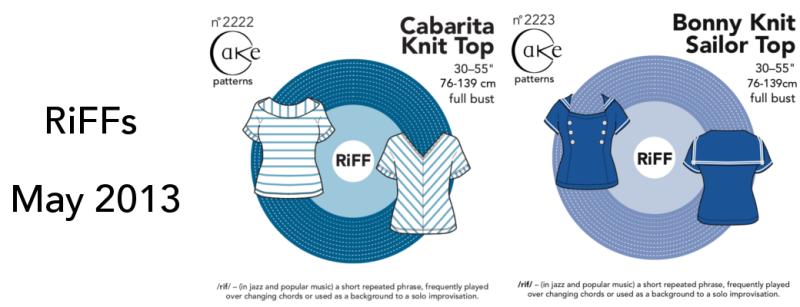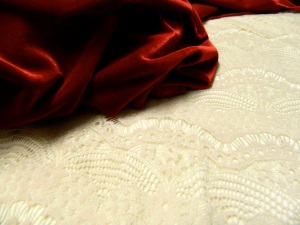 |
| Blog Post |
Any tips for building sewing time into a busy day?
Get a timer. Set the timer. Sew for the duration- 15, 20, 30 minutes. Stay organized- get a box for your project and put everything you need into it because being disorganized is a massive waste of time and energy.
Tip for those who co-habitate: Being a wife/mother/girlfriend/carer does not mean you are a domestic slave. Spending a portion of time every day doing something you want to do is not selfish. Let everyone you live with know you’re sewing until the timer goes off.
If they want to interrupt, teach them about personal boundaries by pointing to the timer and smiling broadly while reminding them you’re sewing until the time is up. Even very small children can be taught to respect this, and it will make them better adults when they grow up.
Do you think sewing can impact a woman's self perception in a positive way?
Absolutely. Everyone wears clothes, and many people have had the experience of shopping for clothes only to find nothing that fits/looks good. In a retail clothing setting, if none of the clothes suit you it’s easy to assume that you’re unsuitable. When someone learns to sew, I see something change in their perception- it’s the understanding that clothes are just pieces of fabric that have been manipulated into a shape that can be used to cover a body.
That changes everything. It marks a shift from the person thinking of themselves as being somehow unsuitable to the understanding that it’s the clothes that don’t suit. Further, sewing is a skill that anyone can acquire with enough practice and patience.
It’s like “Hey look- I just took this pile of thread and buttons and fabric and made it into a shirt! With my own hands!” Sewing itself is an achievement to be proud of outside one’s physical attributes. It’s healthier to think of oneself in terms of skills and achievements than in terms of appearance/size.
Especially for the Stashbusters:
Do you have a stash? How do you keep it under control?
No, I don’t, except the odds and ends of de-stashed fabric that my friends give me. I used to have a stash (because that’s what you do, right?) and I found the guilt rather crushing. So I spent a year sewing it down and haven’t gone back.
I tend to buy all of my fabrics for a “collection” at one time, and coordinate the colors/textures. I almost always buy fabric with an Intent- I have an idea how I’ll use it. Sometimes that changes, but I nearly always sew a fabric within a few months of buying it.
Why should we sew with knits?
A few years ago, when I spent countless hours fitting wasp-waisted 1950’s dresses to my girdled frame and tailoring 19th century menswear for my husband, I scoffed at the thought of “wasting” my precious sewing time on knits.
 |
| blog post |
Eventually, I realized that it made more sense in terms of my time and money to make clothes that would see the most wear in my wardrobe. I can use high quality fabrics and finishes for the garments I wear all the time, and I like the challenge of exhibiting my personal style through “wash and wear” type garments. Sewing knits well is a skill just like tailoring is a skill, but I think it’s often dismissed by sewists as either “too hard” or “not worth it.”
 |
| Pavlova in Action |
I also have a huge problem with the ethics of clothing manufacture. For example: If I go into a store and pick up a shirt for $4 (or even $14 or $24), I know that the fabric alone probably cost more than that. And what about the labor? There’s no way to sugar coat the truth that if I buy a shirt for $4, someone is getting screwed somewhere in the production process, and it’s most likely to be a fellow sewist.
I don’t want to be a part of that system of oppression. Sometimes it seems like there’s no way to escape these systems of oppression as a part of modern life- but this is one way I can abstain. I wouldn’t keep a slave in a shed in my backyard sewing my clothes, so why would I buy clothing that was made under similar conditions? After the most recent (and continual) textile factory tragedies in Bangladesh, it’s even clearer to me that “ethical” oversights by retailers don’t mean anything and that it’s extremely difficult to buy clothes without buying oppression.
 |
| Source Link |
It’s a deliberate choice I make every time I sit down at my sewing machine- I will not prey upon poorer-than-me people so I can wear new clothes.
If I could build a better retail clothing system, I would. But for now, I sew and wear my clothes without guilt.
What is your all time favorite knit to work with and why?
Linen! I love linen jersey, and despite the info out there about dry-cleaning it I have found it’s a really great fabric to toss in the washing machine. Linen fibers are tough. Linen is cool in humid climates, it’s easy to handle and it ages into an unbelievably soft fabric over time. It’s delicious!
What are your Top 5 Tips for working with knits?
- Don’t be afraid. It’s just fabric, and you’re the boss. Start with something cheap, but try to avoid slippery knits at first.
- Use ballpoint needles. The tips of the needles slip between fibers rather than stabbing them (stabbing breaks the fibers and makes runs/ladders in the fabric). This also eliminates skipped stitches.
- Use a knit construction stitch. A narrow and long zig-zag is ideal. A serged/overlocked seam is not sufficient on its own, and a serger/overlocker is not necessary for sewing knits.
- Fusible webbing is your best friend. It holds hems and other seams in place and stabilizes them to prevent rippled stitching without adding bulk. It’s fantastic.
- Woven patterns can often be used to sew knit fabrics without any alteration, but it’s not a good idea to use knit patterns to sew a woven fabric.
What's next or what's the latest for Cake Patterns? Can we get a sneak peek?
 |
| Cabarita Post and Bonny Post |
Well- I just released a new line of patterns, the RiFF range. This has been on the back burner for a few months, it’s so exciting to finally start RiFFing out! RiFFs are a single garment pattern with explicit written instructions and minimalist packaging. They’re intended for intermediate to advanced sewists, and share the same sizing and aesthetic qualities as other Cake Patterns releases.
I can produce a RiFF in a fraction of the time it takes to create a full Cake Patterns release- all those detailed illustration cells don’t make themselves! Though Cake has an artist team to create the illustrations, I work closely with them at every stage of the process to create the illustrations. We spend more hours on edits and refinements than I want to admit! It’s really labor intensive, and while it’s helpful for beginners and visual learners, many people who sew don’t need that kind of instruction- just a few crisply written guidelines. RiFFs are for them.
 |
| Are you drooling with me? How does she know to pick my favorite colors? |
The next “big” Cake Patterns release is Red Velvet- another nifty remake-able knit dress based on the Tiramisu cup-propotional sizing. It has a wide circular neckline that can be faced (optional petal collar!), a secret challenge pocket, midriff section, and a scissor-pleated skirt. I’m playing around with proportions and fabric choices, but the idea is a day-to-cocktail cut which is adaptable depending on the fabrics used.
If you NEED to purchase some of Steph's patterns all the links are here. If you've got any questions on what Steph has said let us know. She hinted there may be more blog posts on some topics if there's interest. Thanks Steph for taking the time to let us get to know you a bit better. Keep up the amazing, inspiring work!
There you go stashbusters! Some extra special motivation for our Knits month. I'm eagerly awaiting my copy of the Hummingbird and Cabarita.

No comments:
Post a Comment